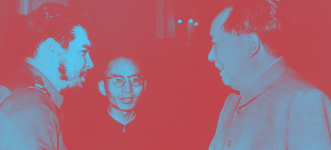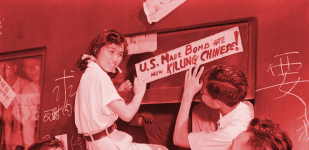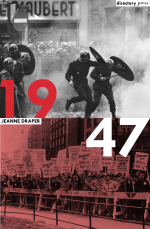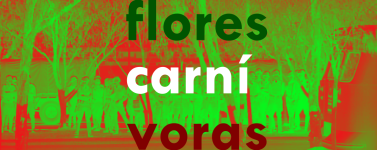
el hombre nuevo socialista
"And let us develop a true proletarian internationalism; with international proletarian armies; the flag under which we fight would be the sacred cause of redeeming humanity. To die under the flag of Vietnam, of Venezuela, of Guatemala, of Laos, of Guinea, of Colombia, of Bolivia, of Brazil—to name only a few scenes of today’s armed struggle—would be equally glorious and desirable for an American, as Asian, an African, even a European." - Guevara, Che. "Vietnam Must Not Stand Alone," New Left Review 43 (1967): 54-57.
April, 1964: Guevara, after the fiasco of the Salta
foco, establishes contacts with Raúl Sandic, labor lawyer and de facto leader of the "
cañeros," a leftist movement of sugar cane cutters famous for a 1961 march on the capitol demanding land expropriation. Sendic, in a meeting with Guevara's confidante Ciro Bustos, requests arms and Cuban trainers to begin the creation of a new
foco centered in the provinces of Florida and Durazno, north of Montevideo. Guevara initially moves to restart the
foco in Salta, but is convinced by Bustos and Pancho Arico that the conditions for guerrilla warfare have not developed in Argentina. Uruguay, given its status as one of the only countries in Latin America to have not yet cut off diplomatic ties with the Cuban government, is ironically positioned well to serve as a potential site of revolutionary activity, given that Cuban aid can easily reach the countryside in the early stages of the revolution. Che gives the all clear to Bustos (and thus Sendic) via cable and begins establishing entry lines, contacts and logistics for the Uruguayan
foco, the Cordoba underground and Cuba.
July, 1964: In response to tightening OAS sanctions on Cuba and hawkish rhetoric from the Johnson Administration, Fidel Castro begins making veiled allusions to a stop in Cuban support for Latin American guerrillas in exchange for detente with the United States. His fig leaf falls on deaf ears, as attacks by CIA-backed exiles step up in intensity and the OAS begins pushing for a total diplomatic break between its members and the Cuban government.
November, 1964: Che visits Moscow with the aim of securing Soviet support for a continent-wide plan of revolution and to try and meditate the Sino-Soviet Split vis a vis their policies towards Latin America. Vitali Korionov, the Deputy Chief of the Soviet America's Department, leaves his meeting firmly believing that Che was both wholly committed to Latin American revolution and firmly on the side of the Chinese. The Soviets refuse to support Cuban intervention in Latin America.
December, 1964: Che delivers the famous "Patria o Muerte!" speech at the UN General Assembly.
February, 1965: Che has secured a secret force with the approval of Castro to intervene in Uruguay. Che flies to Beijing, accompanied by Osmany Cienfuegos (brother of the late Camilo) and Manuel "Barbarroja" Piñeiro Losada (the effective leader of Cuba's efforts to export revolution, behind Che) to secure the tacit support of the Chinese government for the expansion of
focos across Latin America. Meeting with Zhou Enlai and Lin Biao, the Cubans are able to wheedle out promises of Chinese aid for the guerrillas.
March, 1965: Che embarks for Uruguay with over a hundred handpicked Cuban soldiers. They are told they are embarking on "an internationalist mission" with few other details.
August, 1965: Sandic's Tupamaros, now backed with Che's cadre and Cuban materiel, begins attacking National Police stations in Florida Province. Affiliated guerrillas, acting independently from Che's command, engage in a series of bank robberies in Montevideo. Che intervenes and disciplines the gurellilas, causing divisions between the Cuban and Uruguayan soldiers.
January, 1966: The Tupamaros activities continue apace. The National Council Government begins the process of speeding up constitutional reform, investing the powers of the state in a single President. The death of leading Colorado reformer Óscar Diego Gestido by heart attack and the high profile hijacking of a series of delivery vans leaving Montevideo and the dispersal of their contents to rural farmers has led to a surge in popularity for the Tupamaros. Tensions bubble inside the group over whether the guerrillas should follow Che's rural strategy, or, given their growing base among students and the downwardly-mobile Montevideo middle class, orient themselves to moving the
foco south into the urban center.
April, 1966: Piñeiro authorizes the movement of fifty more Cuban soldiers into Uruguay - along with more Cuban arms and, more importantly, direct cash provided jointly by the Cuban and Chinese governments.
November, 1966: The National Council Government grants the military power to "prosecute the insurgency to its fullest extent" after the collapse of National Police authority in Florida and southern Durazno. Che leads an assault on an army barracks along the Yí River; while successful, Che is wounded in the attack, leaving him unable to participate in direct combat. As a result of the attack on the barracks, the broader successes of the Tupamaros and growing government reprisals, the organization is flooded with new recruits. In conjunction with Sandic, Che begins synthesizing the diverging perspectives between the Cuban and Uruguayan guerrillas about the strategy needed for the revolution. Theoretically, he turns to Lin Biao.
May, 1967: Further guerrilla successes have led to a rapid militarization of the Uruguayan government. The bifurcation of Montevideo and the rest of the country has led to a state of emergency being declared in the capitol. The northern countryside has turned rapidly in favor of the Tupamaros, with two columns led by Pepe Mujica and Mauricio Rosencof sweeping through the countryside. The executions of five members of the Uruguayan army and two members of the National Police are widely publicized by both the enemies and proponents of the Tupamaros. The Johnson Administration, while preoccupied with Vietnam, formally condemns the Cuban government for its role as an "international sponsor of terrorism." Castro denies all involvement, and Che's presence in Uruguay remains a secret, with the story of Che fighting in Congo or Guinea-Bisseau being promulgated in the popular presses. The publication of a new edition of Che's "Man and Socialism in Cuba," with a new preface hailing both the Tupamaros movement and the Red Guards in China, causes a wildfire across Latin American leftist circles. The overwhelming majority of formal communist parties across the continent denounce the document. The Soviets begin pressuring Castro to align itself closer to Moscow given tensions between the USSR and China.
July 25th, 1967: Following Lin Biao's strategy of surrounding major cities with guerrilla armies able to consistently apply pressure, the Tupamaros station columns all around the city. On a three day offensive centered around the birthday of Bolivar (July 24th), the Tupamaros push rapidly into the city, causing the collapse of the Uruguayan government. While combat still continues, the majority of forces supporting the government turn in their arms rather than fire on a movement now primarily comprised of students. Sandic provisionally declares a People's Republic of Uruguay from the steps of the Palacio Salvo. Sandic speaks of the "new character" of the Uruguayan nation and people, forged by the fires of revolution, social responsibility, love and collective sacrifice. The "popular masses" of Uruguay were the true drivers of their own liberation, and now it was up to them to begin the process of creating a society fit to live in. Che Guevara is photographed standing behind Sandic. The first two countries to establish diplomatic channels with the revolutionary government are the Republic of Cuba and the People's Republic of China.






